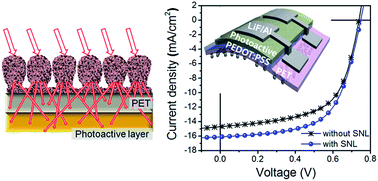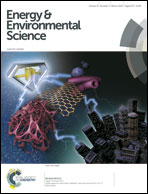Light trapping in bendable organic solar cells using silica nanoparticle arrays†
Abstract
A highly efficient light-scattering layer, composed of quasi-periodic discrete silica nanoparticles directly deposited onto polymer substrates to produce bendable organic solar cells (OSCs) with enhanced light absorption, is reported. A silica nanoparticle layer (SNL) underwent self-assembly on a highly flexible and heat-sensitive polymer at room temperature during fabrication, which employed a unique plasma-enhanced chemical vapour deposition technique. Such efficient light-scattering SNLs have not been realizable by conventional solution-based coating techniques. SNLs were optimized by precisely controlling dimensional parameters, specifically, the nanoparticle layer thickness and interparticle distance. The optimized SNL exhibited an improved transmission haze of 16.8% in the spectral range of 350–700 nm, where reduction of the total transmission was suppressed to 2%. Coating light-scattering SNLs onto polymer substrates is a promising method for improving the light harvesting abilities of OSCs by enhancing the light absorption of photoactive polymer layers. This SNL-based flexible OSC exhibited a record power conversion efficiency (PCE) of 7.4%, representing a 13% improvement, while reducing the thickness of the photoactive polymer layer by 30%.


 Please wait while we load your content...
Please wait while we load your content...